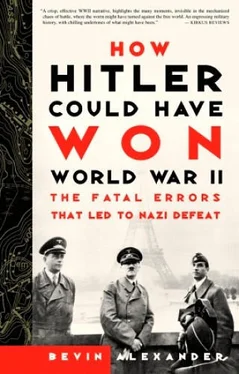Paulus’s mobile spearhead reached the Don near Kalach on July 28, but because of fierce Soviet resistance it was August 23 before 6th Army forced passage of the Don. Massive Stuka bombing attacks on the city during the day and night of August 24 killed many civilians, turned office blocks into rubble, and set fire to wooden structures in older neighborhoods.
Meanwhile, 16th Panzer Division under one-armed General Hans Hube swept aside Russian infantry west of the city and women workers crewing antiaircraft guns at the Barricade gun factory, and reached the Volga near Rynok, ten miles north of Stalingrad, at 6:30 P.M., August 24, 1942. The original purpose had thus been attained: German artillery at Rynok could seal off traffic on the Volga.
On August 27, Stalin appointed General Georgy K. Zhukov as deputy supreme commander of the Red Army, and sent him to direct the defense of Stalingrad.
In oppressive heat (it had not rained for two months), German forces backed by tanks crashed against barricades that blocked nearly every street. Russians fought back from machine-gun nests, within buildings, and amid the rubble. Mortars hidden in holes and crevices dropped shells on the advancing Germans. The Russians defended fortresslike complexes—the steelworks Red October, the artillery factory Barricade, the warehouse complex Univermag, and the tractor plant Dzherhezinsky. The Germans were soon exhausted. Supplies were slow arriving and insufficient; ammunition was in short supply. Progress was slow, counterattacks frequent, and losses high. The name Stalingrad began to have a hypnotic effect on Russians and Germans alike, especially Hitler, who insisted on capture of the entire city.
At Rynok 14th Motorized Corps came under almost unrelenting attack as the Russians tried to sweep around this northern anchor and roll up the German positions. Day after day more than a hundred tanks along with massed Russian infantry hurled themselves against the corps behind a curtain of artillery fire. The Russian commanders ignored high casualties. The only thing that saved the corps was its artillery, the guns sometimes shooting up assembly areas before the Russians could launch their attacks. The Germans learned not to occupy inclines facing the enemy (forward slopes), as they could not be protected from Russian armor. Instead they held the reverse slopes, massing tanks in hollows just behind the main line of resistance, and knocking out enemy armor as it reached the crests above.
General Gustav von Wietersheim, commanding 14th Motorized Corps, watched his strength decline. He recommended that 6th Army be withdrawn to the west bank of the Don, forty-five miles away. The only result was that Hitler removed him because he was “too pessimistic.”
As the German offensives stumbled to a halt, radical changes in leadership came about. On September 10 Hitler relieved List, because his army group had not captured the whole Caucasus. He did not name a successor, and commanded the army group himself in his spare time from supreme headquarters.
Hitler’s long conflict with Halder came to a head. Hitler reproached Halder and the army general staff, calling them cowards and lacking drive. When Halder presented proof of new Soviet formations totaling 1.5 million men north of Stalingrad and half a million in the southern Caucasus, Hitler advanced on him, foaming at the mouth, crying out that he forbade such “idiotic chatter” in his presence.
Halder, who looked and acted like a prim schoolmaster, persisted in explaining what would happen when the new Russian reserve armies attacked the overextended flanks that ran out from the Stalingrad salient. On September 24, Hitler dismissed him.
Hitler said arguments with Halder had cost him half his nervous energy. The army, he said, no longer required technical proficiency. What was needed was the “glow of National Socialist conviction.” He couldn’t expect that from officers of the old German army.
The new chief of staff was Lieutenant General Kurt Zeitzler, a tank expert and man of action. Zeitzler soon took note of the cliques and intrigue in Hitler’s headquarters, became excessively cautious, and did nothing to challenge Hitler’s decision to keep 6th Army at Stalingrad.
Yet, as Field Marshal Manstein wrote: “A far-sighted leader would have realized from the start that to mass the whole of the German assault forces in and around Stalingrad without adequate flank protection placed them in mortal danger of being enveloped as soon as the enemy broke through the adjacent fronts.”
Hitler held stubbornly to the idea that had become fixed in his mind: the enemy was shattered, and would not rise again. He accepted no evidence to the contrary, and he was ready to sack any officer who did not obtain objectives, however unrealistic, or who wanted to pull back to more defensible positions.
Stalingrad had virtually been destroyed. The Germans had gained eight-tenths of the rubble but couldn’t oust the Russians from the rest.
The principal problem, of course, was the flanks. General Hoth had at his disposal on the south two widely spaced corps of the Romanian 4th Army. Beyond the Romanians a 120-mile hole had opened in the Kalmuk steppe, only meagerly veiled by a German motorized division. To the west, the Romanian 3rd Army, Italian 8th Army, and Hungarian 2nd Army held a 400-mile front along the Don. None possessed antitank guns that could stop Russian T-34s.
The Russians had assembled a million men with 13,500 cannons, 900 tanks, and 1,100 aircraft in three army groups or fronts on either side of Stalingrad.
In thick fog on November 19, 1942, Southwest Front commander N. F. Vatutin launched the first arm of a giant pincers movement (Operation Uranus) some eighty miles west of Stalingrad at Kletskaya and Kremensk on the Don. The target was the Romanian 3rd Army. Soviet artillery had previously registered targets, and guns laid down a curtain of shells on the unsuspecting Romanians. Soviet tanks used compasses to guide them. The Romanians stood up to the assault only briefly before they ran away. A giant hole twenty miles wide opened in the German front. Soviet tanks streamed south toward Kalach.
The next day Stalingrad Front commander Eremenko smashed a broad fissure in the Romanian 4th Army south of Stalingrad. This army disintegrated as well. With virtually no opposition, the Russian attack wedge swung to the northwest to link up with the Soviet advance from the Don.
If 6th Army had been given freedom of movement at once it might have broken out of the trap with its men and equipment intact. But Hitler had no intention of allowing the army to retreat, and, when Paulus asked permission to do so, Hitler refused.
On November 22 the Soviet 26th and 4th Tank Corps closed the back of the pincers around Kalach. With this, 250,000 men in twenty German and two Romanian divisions were closed within a pocket at Stalingrad measuring thirty miles east and west, and twenty-five miles north and south.
General Paulus asked for freedom of action, but Hitler refused. The army, Hitler commanded, had to curl up in a ball like a hedgehog. Hermann Göring, chief of the Luftwaffe, promised grandiloquently that the army would be supplied by air until a new battle group could be formed to break the caldron.
Senior Luftwaffe officers said it couldn’t be done, but Hitler listened to Göring, not the air generals.
As the Luftwaffe tried to organize an airlift, the Russians forged a double ring around 6th Army to hinder a breakthrough from either inside or out. They posted 395 antiaircraft guns along the Luftwaffe line of flight and sent in 490 fighters to shoot down the transports.
The daily needs of 6th Army totaled 700 tons. Colonel Fritz Morzik, Luftwaffe air transport chief, said that in the best of circumstances he could fly in 350 tons. The entire Luftwaffe, he pointed out, possessed only 750 Ju-52 cargo aircraft, and there was enormous demand for them elsewhere. Though the air officers pulled additional air freight assets together, along with airplanes from flight schools, they could assemble only about 500 machines, of which on average only a third were ready for operations on any given day. Weather was atrocious, and this reduced deliveries. Göring had ordered at least 300 tons to be flown in every day. But from November 25 to 29 6th Army received 269 tons total, and from November 30 to December 11 only 1,267 tons.
Читать дальше


![Джонатан Димблби - Barbarossa - How Hitler Lost the War [calibre]](/books/385421/dzhonatan-dimblbi-barbarossa-how-hitler-lost-the-w-thumb.webp)









